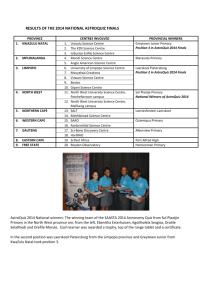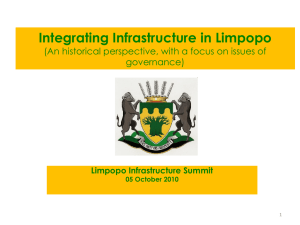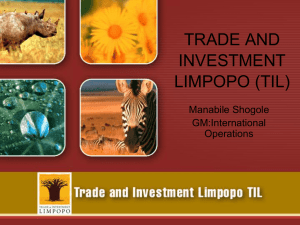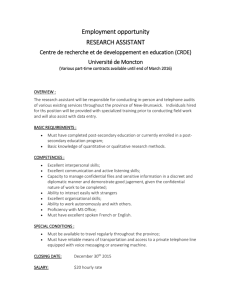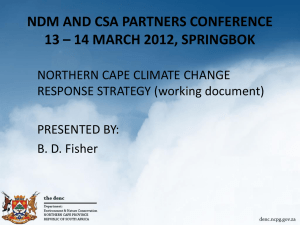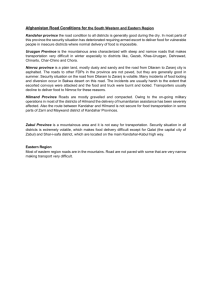Chapter 1: Climate Change - EcoAfrica Environmental Consultants
advertisement
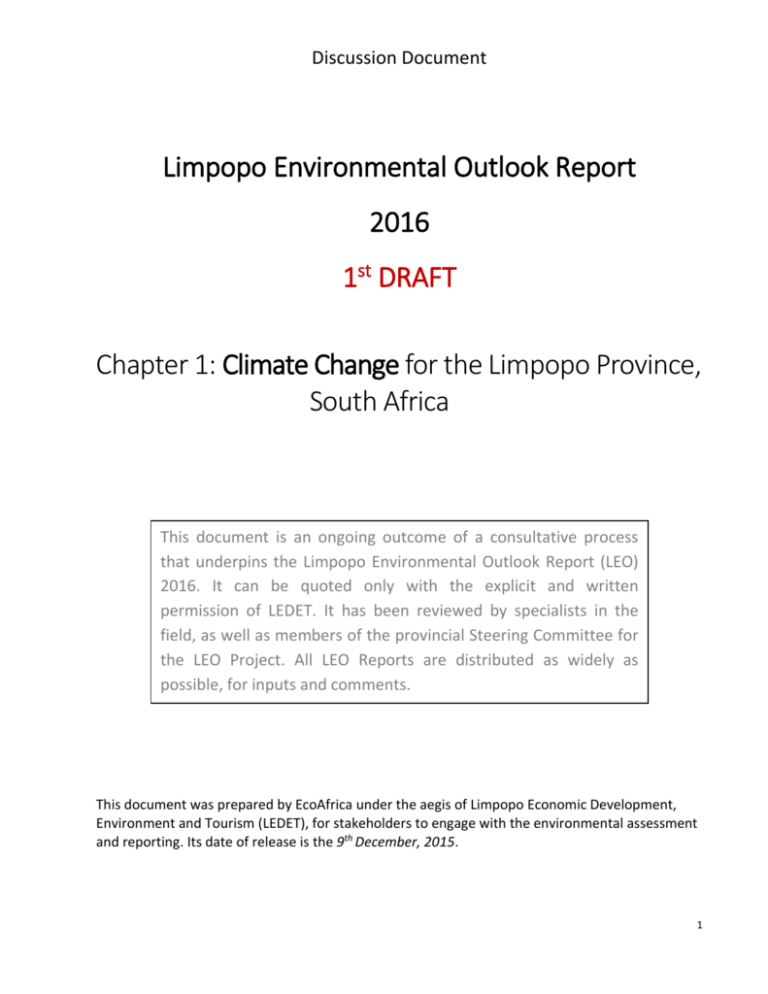
Discussion Document Limpopo Environmental Outlook Report 2016 1st DRAFT Chapter 1: Climate Change for the Limpopo Province, South Africa This document is an ongoing outcome of a consultative process that underpins the Limpopo Environmental Outlook Report (LEO) 2016. It can be quoted only with the explicit and written permission of LEDET. It has been reviewed by specialists in the field, as well as members of the provincial Steering Committee for the LEO Project. All LEO Reports are distributed as widely as possible, for inputs and comments. This document was prepared by EcoAfrica under the aegis of Limpopo Economic Development, Environment and Tourism (LEDET), for stakeholders to engage with the environmental assessment and reporting. Its date of release is the 9th December, 2015. 1 Discussion Document Table of Contents List of Acronyms ......................................................................................................................................... 3 1. Introduction ......................................................................................................................................... 4 2. Drivers and Pressures .......................................................................................................................... 5 3. State, Impacts and Trends ................................................................................................................... 6 4. Global Change Aspects ...................................................................................................................... 12 5. Responses ........................................................................................................................................ 14 6. Conclusions and Recommendations .................................................................................................. 15 References ........................................................................................................................................ 17 List of Figures Figure 1: Pressures on climate change in the Limpopo Province............................................................. 6 Figure 2: Annual rainfall for 4 stations in different climate zones in the Limpopo Province (SAWS, 2015) ........................................................................................................................................ 7 Figure 3: Rainfall for South Africa in mm for the season July 2007–January 2008 (top left), July 2010– January 2011 (top right), and July 2014–January 2015 (bottom), (SAWS, 2015) .................... 7 Figure 4: Average minimum and maximum annual temperature for four stations in different climate zones in the Limpopo Province (SAWS, 2015) ........................................................................ 8 Figure 5: Evaporative demand (mm/day) during September 2015 (ARC, 2015) ..................................... 9 Figure 6: Standardised Precipitation Index for South Africa for period January-December 2005 (left), November 2014-October2015, (SAWS, 2015) ....................................................................... 10 Figure 7: Total annual area burned in the Limpopo Province, 2001 - 2007 based on (NASA, n.d.)....... 11 Figure 8: Index value of vulnerability to climate change for South African municipalities (Turpie & Visser, 2012)........................................................................................................................... 14 List of Tables Table 1: Summary of indicators for the climate change assessment of the Limpopo Province .............. 5 Table 2: Estimated CO2eq emission for the Limpopo Province ............................................................... 11 Table 3: Annual ave. temp. increase projections for the Limpopo/Olifants/Inkomati Hydrological zone (DEA, 2013) .................................................................................................. 12 Table 4: Rainfall projections for the Limpopo/Olifants/Inkomati Hydrological zone (DEA, 2013) ........ 12 Table 5: Direct and indirect effects of climate change on the Limpopo environment and society, ...................................................................................................................................... 13 Table 6: Summary of Climate Vulnerability Assessment for the Limpopo Province. After (DEA, 2015) ......................................................................................................................................... 14 Table 7: Summary of the outlook for climate change based on indicators considered ........................ 16 2 Discussion Document List of Acronyms °C Degrees Celsius CO2 Carbon Dioxide DoE Department of Energy GHG Greenhouse Gasses km2 Squared kilometre LOIH Limpopo-Olifants-Inkomati Hydrological Zone mm Millimetres MODIS Moderate Resolution Imaging Spectroradiometer MWh Megawatt hour SANBI South African National Biodiversity Institute SAWS South African Weather Service SPI Standardized Precipitation Index tpa Tons per annum USD United States Dollars 3 Discussion Document 1. Introduction When talking about climate, allusion is made to the long term average weather patterns of a given region (i.e. temperature, pressure, precipitation). In this context, climate change then refers to perceived increases in the long term average temperature of the earth’s climate system. This temperature increase alters typical processes of ice formation and melting, changes the hydrological cycles and modifies the air and ocean currents. As a consequence, social, biological and ecological systems are also affected; and there is a strong threat on food supply, health, availability of water resources, economic growth, etc. The understanding of climate change has been growing and today scientist are 95% certain that the perceived increases in global temperature are mostly caused by the concentration of Greenhouse Gases1 (GHG) in the atmosphere and other human activities (IPCC, 2014). Solar radiation penetrates into the earth warming its surface; however only a fraction of this radiation is returned back to the space as most of it is trapped by the accumulation of these GHG gasses. The trapped radiation goes back to heat up the earth’s surface, increasing its temperature just as a greenhouse operates. Most of the GHG are present naturally in the atmosphere in small proportions; however since the industrial revolution their concentration has notably risen. This rise has primarily been linked to the combustion of fossil fuels driven by the demand for energy, goods and services, and to the conversion of natural ecosystems to intensive land use. Each of the last three decades has been successively warmer at the Earth’s surface than any preceding decade since 1850. The globally averaged surface temperature shows a warming of 0.85°C over the last 30 years (IPCC, 2014). Mitigation plans for a substantial emission reduction of GHG are needed around the globe to limit the warming below 2oC2. South Africa may be one of the few African countries that could contribute to mitigating climate change, as its carbon intensity economy places the country as the number 12 contributor world wide of CO2 emissions (WDI, 2011). Africa is one of the most vulnerable continents to climate change because of multiple stresses and low adaptive capacity. The southern African region is prone to the occurrence of droughts and floods (Meadows, 2006), and the panorama for Limpopo is not different. Main concerns are found around an increased water stress and a reduction in agriculture, affecting food security and worsening malnutrition. During the last five decades the mean average temperature in South Africa has increased by 1.5 times the observed global average of 0.65oC. Maximum and minimum temperatures have increased across the country, and rainfall has shown high interannual variability and less number of rain days almost everywhere in the country, especially during the autumn months (DEA, 2013). The Limpopo province is particularly vulnerable to climate change, as not only extreme climate events are expected but the low adaptive capacity of the province is pressuring the resilience of the more fragile communities and ecosystems. Africa is one of the most vulnerable continents to climate variability and change because of multiple stresses and low adaptive capacity. The livelihoods of people in Africa, including South Africa, are often directly linked to the climate of the area (CSIR, 2010). 1 The primary GHG in the earth atmosphere are: Carbon dioxide (CO2), methane (CH4), nitrous oxide (N2O), Ozone (O3), Chlorofluorocarbons (CFCs) and water vapor. 2 Relative to pre-industrial levels 4 Discussion Document In this chapter an assessment on the climate change status of the Limpopo Province is performed from the observed weather changes, carbon footprint and vulnerability; using the described indicators in Table 1 as a framework. While reading this chapter, keep in mind that climate change is a cross-cutting issue and thus considerations in this regard are presented in most of the other chapters including the ones related to energy, water, land, human settlements and biodiversity. Table 1: Summary of indicators for the climate change assessment of the Limpopo Province Indicators Considered Rain Temperature Evaporation Disturbance regimes: Flood Drought Fire Carbon footprint Description and Comment Annual rainfall for four different stations across the four climatic zones of the Limpopo Province. Average min and max temperature for four different stations across the four climatic zones of Limpopo Province. Potential Evapotranspiration Standardised Precipitation Index Comparison Area burned per year Estimated CO2eq emissions per type of source 2. Drivers and Pressures Without a doubt, the main drivers of climate change are population and economic growth. As the population numbers increase, more people aspire to higher material standards - creating an even greater demand for goods and services as for the energy to provide these. Transportation, industry, commerce, and the residential sector are the greatest contributors to GHG emissions, due to their high demand of energy which is supplied from non-renewable sources. The energy sector in South Africa is responsible for about 89% of the national emissions of CO2, mainly from energy industries (57%), transportation (9%) and manufacturing and construction (9%) (DEA, 2014). Other sources of emissions are industrial processes and agriculture and land usage. A brief description of pressuring activities for the Limpopo Province is presented below in Figure 1. Each one of these activities has been discussed in more detail in other chapters of this document. Power generation •Electricty generation mainly from coal, that suplies provincial and national needs •Minimun development of renewal energy projects •Power stations are the main source of CO2 in the province Industry •Energy intense industries such as mining and mining related activities •Industrial energy inneficient systems Residential •One of the greatest consumers of electricity •Strongly influences the electricty consumpption patterns, which is a challenge for secure supply of energy from renewable sources 5 Discussion Document Transport Agriculture Waste •High flow of vehicles and heavy duty vehicles •Connecting road networks for South Africa, Zimbabwe and Botswana •Methane emissions from poor sanitation facilities and limited service delivery •Prevalecence of burning practices for disposal of waste •Deforestation and land transformation •Methane emissions from cattle and game •Fertilizers in agriculture a great scale Figure 1: Pressures on climate change in the Limpopo Province 3. State, Impacts and Trends Climate change is becoming increasingly apparent in Limpopo. The usual manifestations of climate change are evident by the long term changes in weather indicators such as rainfall or temperature. This section presents briefly the weather records for the Limpopo Province as indicators of climate change. The Limpopo Climate Rainfall Four climatic regions can be distinguished in the Province: a. The subtropical plateau, a flat elevated interior area hot and dry with winter rain. b. The moderate eastern plateau with warm to hot and rainy summers, and cold dry winters. c. The escarpment region with colder weather because of the altitude and rain all year around; and d. The subtropical Lowveld region, of hot-rainy summers and warm-dry winters, also known as the South African Bushveld. c a d b 3 Typical rainfall for the province ranges from 200mm in the hot dry areas to 1500mm in the high rainfall areas, with most of it happening between October and April. Rainfall in the province varies significantly between years. There has been a perceptible decrease in the total rainfall on much of the eastern part of Southern Africa including most of the Limpopo River Basin (Malherbe, et al., 2012). This can have serious impacts on the water balance of the region, affecting the largely rural population dependant on agriculture. Figure 2 shows the annual rainfall for the period 1993-20153 as recorded at different stations across the four Limpopo Climatic Zones. These are: Lephalale station in the subtropical plateau, Mokopane station in the eastern plateau, Tzaneen station in the escarpment, and Phalaborwa station in the Lowveld. Inter-annual variations are observed as expected, and a decreasing trend is seen especially in the Mokopane and Tzaneen stations. A comparison of rainfall for the season July-January presents notable reduction in the rainfall over Province and the rest of the country (refer to Figure 3) When available. December not included. 6 Discussion Document Figure 2: Annual rainfall for 4 stations in different climate zones in the Limpopo Province (SAWS, 2015) Figure 3: Rainfall for South Africa in mm for the season July 2007–January 2008 (top left), July 2010– January 2011 (top right), and July 2014–January 2015 (bottom), (SAWS, 2015) 7 Discussion Document Temperature Evidence from observations indicates a strong warming trend, this has already manifested itself over southern Africa (Kruger & Shongwe, 2004). Projected increases in air temperatures for South Africa are likely to be higher over the interior and lower over the coast (DST, 2010). Average annual minimum and maximum temperatures for the last 20 years across the Province are displayed in Figure 4Figure 2, the increasing trend is recognisable especially for the case of maximum temperatures. Figure 4: Average minimum and maximum annual temperature for four stations in different climate zones in the Limpopo Province (SAWS, 2015) 4 Evaporation High levels of evaporation mean that the soil dries up quickly reducing the amount of water available for plant uptake; this results in crops being more prone to drought. Dryland subsistence farming is generally not viable given the variable rainfall, high evaporation and high evapotranspiration. Evaporation is highest during the rainfall season, and it significantly reduces effective rainfall, runoff, soil infiltration and groundwater recharge. The Evaporative Demand in Limpopo ranges from about 2 mm to 5 mm per day. Figure 5 presents the calculated Potential Evapotranspiration for the month of September 2015, calculations are based on measured temperature, humidity, wind and solar radiation data. Potential evapotranspiration remains high for the province, especially in the western regions. The projected increase in temperature will partially offset any 4 Tzaneen Station was relocated in 2006/07 from “Grenshoek Tzaneen” to “Tzannen Westfalia state” 8 Discussion Document increase in rainfall, due to an increase in potential evaporation of about 5% per 1oC (Schulze, 2010), what translates into less water available for use in the future. Figure 5: Evaporative demand (mm/day) during September 2015 (ARC, 2015) Disturbance regimes The increase in extreme events may be at least partially attributed to the significant increase in surface temperatures over the region. Such an increase would be favourable to the occurrence of heat convection and convective rainfall. For South Africa, high impact climate events such as heat-wave days and high fire-danger days are consistently projected to increase drastically in their frequency of occurrence (Engelbrecht, et al., 2015). Reference is made below to some events -drought, floods and fires- ; although quantification of such is not a straightforward task. Its importance lies as the resilience to climate variability and extreme weather events are the basis for a disaster management approach. Drought Drought is considered one of the most complex and least understood of all natural hazards, affecting more people than any other hazard; but it is also the most important natural disaster in southern Africa in economic, social and environmental terms (Buckland, et al., 2000). It is believed that at least 60 percent of sub-Saharan Africa is vulnerable to drought and probably 30 percent is highly vulnerable. Extreme drought in the Limpopo River Basin is a regular phenomenon and has been recorded for more than a century at intervals of 10-20 years, although the periodicity of droughts is not necessarily so predictable (FAO, 2004). Defining and monitoring drought is a difficult task due to its diverse geographical and temporal distribution. Based on rainfall events, the Standardized Precipitation Index is the most used tool to investigate drought. The SPI gives the deviation of rainfall events in a selected time scale from the long-term mean. An example of SPI calculated for South Africa is displayed in Figure 6. 9 Discussion Document Figure 6: Standardised Precipitation Index for South Africa for period January-December 2005 (left), November 2014-October2015, (SAWS, 2015) Floods Short duration-intense rainfalls result in floods that can potentially cause serious problems to urban infrastructure (i.e. dams, bridges, and storm water systems), population of informal settlements located in floodplains, and agriculture. The impacts and economical loses of extreme events is such that some authors (Von Storch & Zwiers, 1988) suggest to focus climate change analysis on changes in extreme events rather than changes on climatic means. The global risk platform5 indicates the average economic loss for a country due to disasters. The estimated amount for South Africa Flooding in Bela-Bela, Limpopo -March 2014 during the period 2005 to 2014 was of 118 million USD; 30% of this amount is due to flood events and 20% from storm events. The projected change in the frequency of occurrence of extreme rainfall events is defined as 20 mm of rain falling within 24 hours over an area of 0.5° x 0.5° (Engelbrecht, et al., 2012). Recent information regarding changes in extreme rainfall events and heavy daily rainfall in Limpopo and South Africa is limited. Higher rainfall projections with less rainfall days indicate that the events and the possibility of severe rain events may increase (CSIR, 2010). Fires Other serious impacts brought by drought and aggravated by strong winds are the devastating veld fires, which destroy large areas of grazing at a time when grass is in short supply. Commercial timber and orchards are also prone to damage at such times (SAWS, 2015). The Waterberg and Mopani DM are particularly susceptible to experience fires on the denominated grassland, bushland and woodlands, especially during the months of July to September. Figure 7 presents the total annual burned area in the Limpopo Province for the period 2002 to 2007 as recorded from satellite images. 5 http://www.preventionweb.net/countries/zaf/data/ 10 Discussion Document Figure 7: Total annual area burned in the Limpopo Province, 2001 - 2007 based on (NASA, n.d.) Carbon foot print The latest published national greenhouse gas inventory for South Africa, was conducted for the period 20002010, finding the energy generation as the main contributor to national emissions of GHG (78%) (DEA, 2014). This inventory is developed at national level and does not discriminate emissions per province. Up to date there is not an official GHG inventory published for the Limpopo Province; although the nomination of GHG as criteria pollutants, and the future implementation of a national reporting system national reporting system of emissions is expected to facilitate the task in the middle-long term. For the development of this document, an estimation of GHG emissions for the province was attempted from the compilation of partial results published in different sources, the summary is presented in Table 2 below. Likewise national results, it is power generation the main contributor to the CO2eq emissions of the province. Table 2: Estimated CO2eq emission for the Limpopo Province Source of emissions CO2(eq) tpa 67 % Total Source of information 25,000,000 82.% Eskom7 Small Boilers 1,564,928 5.1% Limpopo AQMP8 Liquid fuels (exc. traffic) 1,229,001 4.0% Agriculture Game 951,176 3.1% (du Toit, et al., 2013) Biomass (veld fires) 715,367 2.3% 10 Traffic 578,214 1.9% Limpopo AQMP8 Sanitation 178,964 0.6% 11 Agri. Small stock 126,865 0.4% (du Toit, et al., 2013) Brickworks 82,309 0.3% Limpopo AQMP8 Fertilizer Manufacturing 43,305 0.1% Limpopo AQMP8 Power gen (exc. Medupi ) Solid Waste no available - Residential wood/coal no available - Est. Total Limpopo 9 30,470,130 6 Medupi CO2 emissions expected=0.75 tons/MWh (about 32 million tons once fully operational) http://www.eskom.co.za/OurCompany/SustainableDevelopment/ClimateChangeCOP17/Documents/ Air_quality_and_climate_change.pdf 8 Provincial Air Quality Management Plan (LEDET, 2013) 9 Estimated from 2014 Provincial sales of liquid fuels from the DoE (http://www.energy.gov.za/files/energyStats_frame.html), and Defra emissions factors 10 Estimated from burned area from MODIS burned scar data, and emissions factor from 2006 IPCCC guidelines 11 Estimated from type of sanitation per household (2011 Census-StatsSA) and emissions factors from 2006 IPCCC guidelines 7 11 Discussion Document Est. National emissions 201012 Provincial % of national 518,239,000 5.9% 4. Global Change Aspects Climate scenarios for South Africa have been modelled through local Temperatures over Limpopo are and international climate modelling expertise13, over six hydrological projected to increase drastically, zones (DEA, 2013). The Limpopo province is included within the reaching a regime never observed Limpopo-Olifants-Inkomati Hydrological (LOIH) zone. During the before in the recorded climate of the modelling results, less uncertainty was found in temperature region (DEA, 2013) predictions than in rainfall predictions. Notice that only general conclusions of the study are presented in this document, for additional information regarding methodology and complete results the reader is referred to the Long Term Adaptation Scenarios Report and the Climate trends and scenarios for South Africa Technical report. Minimum temperatures experienced in Limpopo have increased about 0.5-1.2oC in the last twenty years, and about 0.6-0.9oC for maximum recorded temperature. Modelled results for temperature in the near future for the LOIH zone suggest a scenario within the realm of present days, with slighted increase towards 2030 reaching 2oC. Mid-future scenario suggest an increase on temperatures between 1-5oC; and the long term scenario predicts an increase between 3-7oC from the baseline scenario. Table 3: Annual ave. temp. increase projections for the Limpopo/Olifants/Inkomati Hydrological zone (DEA, 2013) Scenario Period Annual average temperature increase Baseline (1971-2005) Near-Future (2015-2035) 2oC Within realm of present day climate Mid-Future (2040-2060) 1-3oC (2-5oC) Beyond present say climatology range Long term (2080-2100) 3-6oC (4-7oC) Well beyond natural temp. variability Rainfall projections for the LOIH zone are presented in Table 4 for four possible scenarios. The probability of occurrence of scenario 3 and 4 is reduced significantly if mitigation strategies are put on place. However, even under strong mitigation responses, wetter or dryer scenarios are expected to bring socio-economic implications for vulnerable communities in the form of water resource availability and frequency of extreme events (i.e. droughts, floods). Table 4: Rainfall projections for the Limpopo/Olifants/Inkomati Hydrological zone (DEA, 2013) Scenario Expected rainfall Season Likelihood of occurrence if mitigation plans 1- Warmer/wetter Increase Spring and summer Same 2- Warmer/drier Decrease Summer, spring, autumn Same 3- Hotter/wetter Strong increase Spring and summer Reduced 4- Hotter/drier Strong decrease Summer, spring, autumn Reduced 12 (DEA, 2014) 13 Using statistical and dynamical downscaling methodologies based on outputs from IPCC AR4 and IPCC AR5. These represent an unmitigated future energy pathway and mitigated future energy pathway. 12 Discussion Document Projected changes in rainfall and temperatures carry the potential of affecting directly or indirectly the environment, society and economy. Table 5 presents a summary of the expected impacts that climate change can have in different areas in the Limpopo Province. Nevertheless, beyond the potential impacts, a more complete climate change analysis of a region should include the exposure and resilience of the different communities to these impacts through a vulnerability assessment. Table 5: Direct and indirect effects of climate change on the Limpopo environment and society, after (Schulze, 2010; DEA, 2015) Sector Climate change effects Water Agriculture Biodiversity Social Decrease in summer rainfall Low/High river flows are anticipated to decrease leading to water shortages Increased evapotranspiration (potential evaporation of about 5% per 1oC ) and decreased soil moisture Reduced recharge of groundwater and falling water levels in boreholes. Flooding, contamination of available water and droughts Decreased productivity of food crops Increased crop irrigation requirements due to increased temperature Decreased soil moisture levels as a result in changed runoff patterns Crops grown on marginal land will have to contend with land degradation and reduced soil productivity. Crop and livestock production could be adversely affected by changes in the distributions of diseases, pests and insects High vulnerability of certain agricultural crops due to decreased water availability and increased temperature Increased heat stress on plants, animals and humans Changing ecosystems leading to species shifts and extinction Increased alien vegetation and increased risk of wild fires Food security Health impacts will arise or worsen due to both climate stresses, and climate shocks Damage of livelihoods Vulnerability In climate change, vulnerability is typically given by the exposure and sensitivity to climate stress on one hand; and the capacity to deal with the effects of that stress on the other (Eakin & Luers, 2006). South African most recent index of vulnerability to climate change of the local municipalities is presented in Figure 8 (Turpie & Visser, 2012). This vulnerability index was calculated taking into account two sets of variables; the climate related potential impacts (i.e. flood frequency, change in temp., water stress), and the adaptive capacity (i.e. infrastructure, governance). The results place the Limpopo’s municipalities in a highly vulnerable situation, particularly in zones corresponding to former homeland areas. Seven municipalities from Limpopo are found within the list of the twenty municipalities declared as highly vulnerable, these are: Ephraim Mogale, Elias Motsoaledi and Fetakgomo in the Shekhukhune DM, Greater Giyani and Greater Letaba in the Mopani DM, Thulamela in the Vembe DM and Aganang in the CDM. The Province is followed in number by the Eastern Cape Province with five municipalities in the list. As the key areas relating to this poor performance the DMs have identified 13 Discussion Document the need for a strong and improved governance, deforestation, deficient waste management systems and lack of infrastructure, amongst others (DEA, 2015). Figure 8: Index value of vulnerability to climate change for South African municipalities (Turpie & Visser, 2012) An important step towards building an adequate climate adaptation strategy for the Limpopo province is to identify the key areas of vulnerability or a Vulnerability Assessment. The current assessment reveals that the sectors in Limpopo province displaying greater climate change vulnerability, in relative terms, are: agriculture, rural livelihoods and settlements, terrestrial and aquatic ecosystems, water supply, and (more so in the long term) public health and safety, plus disaster management (DEA, 2015). A summary of the assessment is displayed in Table 6 below. Table 6: Summary of Climate Vulnerability Assessment for the Limpopo Province. After 5. Responses The national response to climate change involves two aspects: the mitigation approach by reducing the GHG emissions, and the adaptation response involving the preparation to deal with the climate change impacts. Mitigation plans are outlined in the National Climate Change Response White Paper stating the goal of reducing 34% and 42% of the “Business as Usual” GHG emissions by 2020 and 2025. Other mitigation initiatives include 14 Discussion Document the development of renewable energy projects through the Renewable Energy Independent Power Producer Procurement Programme, the Energy Efficiency Strategy and the Solar Water Heater Rebate Programme. Regarding adaption strategies, the efforts from the national government include the development of the Long Term Adaptation Scenarios and Climate Change Vulnerability Assessment (DEA, 2013) to ensure that food, water, energy security and infrastructure is not negatively impacted by climate change. As for the implementation of high climate change adaptation projects, the SANBI has selected two areas, one of them will take place in the Mopani District of Limpopo. In terms of Provincial response, identification of the needs and intentions of shifting towards a green, low carbon economy were stated in the Limpopo Employment, Growth and Development Plan 2009-2014. The first official step is given in 2011 with the Limpopo Green Economy Plan and Climate Change Response; this document highlights the advantages that the Province has for implementing a green economy, and defines short, medium and long terms interventions in ten key focus areas. The goals are around job generation, improvement of environmental quality, and creating conditions for green growth and different production patterns. In 2013, the Climate Change Response Tool for Municipalities in Limpopo exposed the vulnerability of each of the municipalities and identified critical issues related to climate change for each one of them and pointed a responsible person for action. Currently, the Province is completing the Provincial Climate Change Vulnerability Assessment and Adaptation Strategies Project which started on January 2015. This project aims to assess the sensitivity, vulnerability and adaptation capacity that the different systems in the province have to face climate change and its potential impacts. Conclusions of this project are expected in middle 2016; however preliminary results have been included in this chapter when possible. 6. Conclusions and Recommendations Limpopo is perhaps the most vulnerable province to climate change in South Africa. Besides expecting a high increase in temperatures, strong variations in rainfall patterns and more frequency of extreme events, the province is also very susceptible as it already faces multiple pressures from poverty, inadequate housing and poor access to services, to name a few. Observed data indicates increases in temperatures and variations in rainfall across the province, and it could be said that Limpopo is already meeting the effects from climate change. The consequences of experienced extreme events between 2014 and 2015 are exposing the lack of preparation of the province to handle climate variations. Notable efforts have been done by the Province in the development of a framework and strategies to address mitigation and adaptation; however the lack of appropriated changes in governance limits improved resilience. It is expected that the biggest challenge that mitigation and adaptation plans would face will be the integration and effective implementation at local municipality level. Additionally to keeping the record of changes in rainfall, temperature, evaporation, etc., a climate change indicator for the province should be able to display the efficiency of the efforts for mitigation and adaptation. Therefore a quantification of carbon footprint and a vulnerability assessment is recommended to be included in further reviews of the state of the environment. A rough estimation of GHG emissions presents Power generation as the biggest source of emissions in the province. Agriculture, rural settlements, aquatic ecosystems and water supply are the most vulnerable sectors to climate change; public health and disaster management are also threatened at medium term. A summary of the findings for the selected indicators for climate change assessment is presented in Table 7 below. 15 Discussion Document Table 7: Summary of the outlook for climate change based on indicators considered Indicators Considered Rain Temperature Evaporation Disturbance regimes Carbon footprint Quantification Overall decrease in rainfall across all climatic zones of the province Increase in annual max/min average temperature High potential evapotranspiration across the province: >3 mm/day Flood/Drought: Not available reports on number of events per year. Differences in geographical extension, duration, severity, etc. make of these elements difficult of being “quantified” with a comparative purpose. Fire: Variable Estimated CO2eq: 30,470,130 tpa Trend Variable/declining Increasing Increasing Not enough information to draw a trend Not enough information to draw a trend 16 Discussion Document References ARC, 2015. Umlindi (September edition), Pretoria: Agricultural Reseacrh Council - Institute for Soil, Climate and Water. Buckland, R., Eele, G. & Mugwara, R., 2000. Humanitarian crises and natural disasters: a SADC perspective, London: European Association of Development Research. CSIR, 2010. A climate change handbook for the North-Eastern South Africa, Pretoria: Climate Change Research Group. DEA, 2013. Long Term Adaptation Scenarios Flagship Research Programme (LTAS) for South Africa. Climate Trends and Scenarios for South Africa, Pretoria: Department of Environmental Affairs. DEA, 2014. GHG National Inventory Report South Africa 2000-2010. Pretoria: Department of Environmental Affairs, GIZ. DEA, 2015. 2012 SOUTH AFRICA ENVIRONMENT OUTLOOK, Pretoria: Department of Environmental Affairs. DEA, 2015. Climate Support Program (CSP) Vulnerability Assessment, s.l.: Department of Environmental Affairs, GIZ. DEA, 2015. Climate Support Programme (CSP) Climate change adaptation strategies. Adaptation Strategies for the Limpopo Province, s.l.: Department of Environmental Affairs, GIZ. DST, 2010. South African Risk and Vulnerability Atlas, www.rvatlas.org : Department of Science and Technology. du Toit, C., Meissner, H. & van Niekerk, W., 2013. Direct greenhouse gas emissions of the game industry in South Africa. South African Journal of Animal Science, 43(3). du Toit, C., van Niekerk, W. & Meissner, H., 2013. Direct greenhouse gas emissions of the South African small stock sectors. South African Journal of Animal Science, 43(3). Eakin, H. & Luers, A., 2006. Assessing the vulnerability of social-environmental systems. Annual Review of Environment and Resources, Volume 31, pp. 365-394. Engelbrecht, C., Engelbrecht, F. & Dyson, L., 2012. High-resolution model-projected changes in midtropospheric closed-lows and extreme rainfall events over southern Africa. International Journal of Climatology, 33(1), pp. 173-187. Engelbrecht, F. et al., 2015. Projections of rapidly rising surface temperatures over Africa under low mitigation. Environmental Research Letters. FAO, 2004. Drought impact mitigation and prevention in the Limpopo River Basin: A situation analysis, Rome: Food and Agriculture Organization of the United Nations. IPCC, 2014. Cimate Change 2014 Syntesis Report - Summary for Policiymakers, s.l.: Interngovernmental Panel for Climate Change. 17 Discussion Document Kruger, A. & Shongwe, S., 2004. Temperature trends in South Africa: 1960-2003. International Journal of Climatology, Issue 15, pp. 1929-1945. Malherbe, J., Engelbrecht, F. & Landman, W. A., 2012. Projected changes in tropical cyclone climatology and landfall in the Southwest Indian Ocean region under enhanceD anthropogenic forcing. Meadows, M., 2006. Global change and southern Africa. Geographical, Issue 44, pp. 135-145. NASA, n.d. Moderate Resolution Imaging Spectroradiometer (MODIS). [Online] Available at: https://earthdata.nasa.gov/earth-observation-data/near-real-time/download-nrt-data/modisnrt [Accessed 03 10 2015]. SAWS, 2015. Annual rainfall, min/max temperature, Pretoria: South African Weather Services. SAWS, 2015. Drought Monitoring – October, Pretoria: South African Weather Services. SAWS, 2015. Historical Rain Maps. [Online] Available at: http://www.weathersa.co.za/climate/historical-rain-maps [Accessed 30 11 2015]. SAWS, 2015. What kind of droughts does South Africa experience?. [Online] Available at: http://www.weathersa.co.za/learning/climate-questions/36-what-kind-of-droughts-doessouth-africa-experience [Accessed 30 11 2015]. Schulze, R., 2010. Atlas of Climate Change and the South African Agricultural Sector: A 2010 Perspective, Pretoria: Department of Agriculture, Forestry and Fisheries. Turpie, J. & Visser, M., 2012. The Impact of Climate Change on South AfricaʼS Rural Areas . In: Technical Report: Submission for the 2013/14 Division of Revenue - For an Equitable Sharing of National Revenue. Midrand: Financial and Fiscal Comission, pp. 127-220. Von Storch, H. & Zwiers, . F. W., 1988. Recurrence Analysis of Climate Sensitivity Experiments. Journal of Climatology, Issue 1, p. 157–171. WDI, 2011. The World Bank Data. [Online] Available at: http://data.worldbank.org/indicator/EN.ATM.CO2E.KT/countries?order=wbapi_data_value_2011%20wbapi _data_value%20wbapi_data_value-first&sort=desc&display=default [Accessed 14 11 2015]. 18
